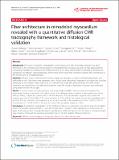Fiber architecture in remodeled myocardium revealed with a quantitative diffusion CMR tractography framework and histological validation
Author(s)
Mekkaoui, Choukri; Huang, Shuning; Chen, Howard H.; Dai, Guangping; Reese, Timothy G; Kostis, William J; Thiagalingam, Aravinda; Maurovich-Horvat, Pal; Ruskin, Jeremy N; Hoffmann, Udo; Jackowski, Marcel P; Sosnovik, David; ... Show more Show less
Download1532-429X-14-70.pdf (4.027Mb)
PUBLISHER_CC
Publisher with Creative Commons License
Creative Commons Attribution
Terms of use
Metadata
Show full item recordAbstract
Background: The study of myofiber reorganization in the remote zone after myocardial infarction has been performed in 2D. Microstructural reorganization in remodeled hearts, however, can only be fully appreciated by considering myofibers as continuous 3D entities. The aim of this study was therefore to develop a technique for quantitative 3D diffusion CMR tractography of the heart, and to apply this method to quantify fiber architecture in the remote zone of remodeled hearts. Methods: Diffusion Tensor CMR of normal human, sheep, and rat hearts, as well as infarcted sheep hearts was performed ex vivo. Fiber tracts were generated with a fourth-order Runge-Kutta integration technique and classified statistically by the median, mean, maximum, or minimum helix angle (HA) along the tract. An index of tract coherence was derived from the relationship between these HA statistics. Histological validation was performed using phase-contrast microscopy. Results: In normal hearts, the subendocardial and subepicardial myofibers had a positive and negative HA, respectively, forming a symmetric distribution around the midmyocardium. However, in the remote zone of the infarcted hearts, a significant positive shift in HA was observed. The ratio between negative and positive HA variance was reduced from 0.96 ± 0.16 in normal hearts to 0.22 ± 0.08 in the remote zone of the remodeled hearts (p<0.05). This was confirmed histologically by the reduction of HA in the subepicardium from −52.03° ± 2.94°; in normal hearts to −37.48° ± 4.05°; in the remote zone of the remodeled hearts (p < 0.05). Conclusions: A significant reorganization of the 3D fiber continuum is observed in the remote zone of remodeled hearts. The positive (rightward) shift in HA in the remote zone is greatest in the subepicardium, but involves all layers of the myocardium. Tractography-based quantification, performed here for the first time in remodeled hearts, may provide a framework for assessing regional changes in the left ventricle following infarction.
Date issued
2012-10Department
Harvard University--MIT Division of Health Sciences and TechnologyJournal
Journal of Cardiovascular Magnetic Resonance
Publisher
BioMed Central Ltd
Citation
Mekkaoui, Choukri et al. “Fiber Architecture in Remodeled Myocardium Revealed with a Quantitative Diffusion CMR Tractography Framework and Histological Validation.” Journal of Cardiovascular Magnetic Resonance 14.1 (2012): 70. Web.
Version: Final published version
ISSN
1097-6647
1532-429X